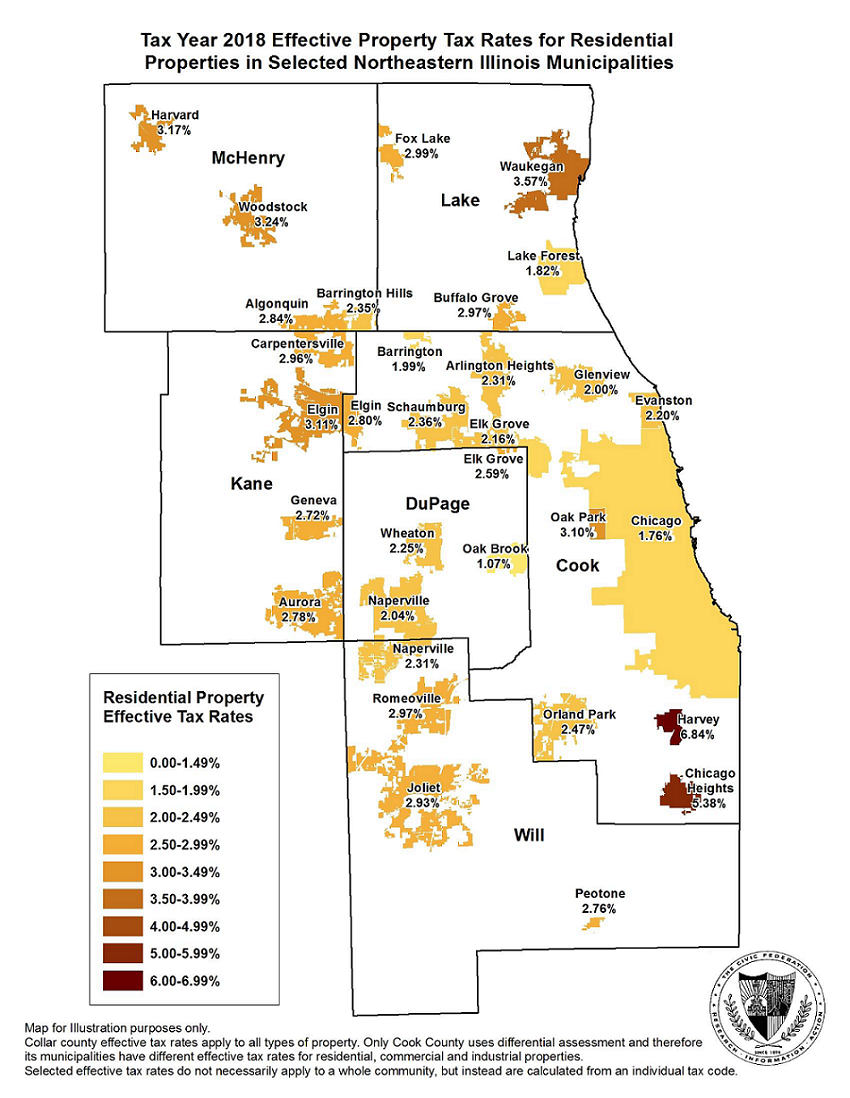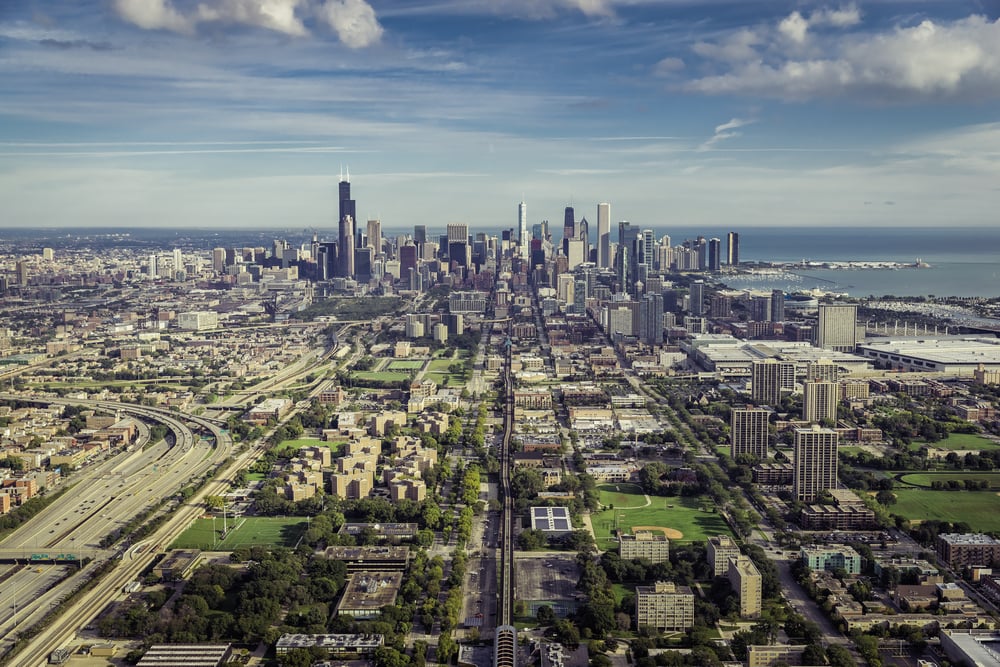March 02, 2021
Click here to read the full report.
Click here to read the press release for this analysis.
MAJOR FINDINGS
Effective property tax rates are a measure of property tax burden for homeowners and businesses. They translate the tax rates on property tax bills into rates that reflect the percentage of full market value that a property owed in taxes for a given year.
This report, produced annually by the Civic Federation, estimates the tax year 2018 (taxes payable in 2019) effective rates for Chicago and 28 other selected municipalities in northeastern Illinois. Of the municipalities, 12 are in Cook County (including Chicago) and 19 are in the collar counties. There are three municipalities included in the study that are located in two counties: Elgin overlaps Cook and Kane Counties, Elk Grove Village overlaps Cook and DuPage Counties and Naperville overlaps DuPage and Will Counties[1].
The map below shows effective property tax rates for residential properties in the selected municipalities in tax year 2017.

In Cook County, six of the 12 municipalities experienced an effective property tax rate decrease on residential property in tax year 2018 compared to the previous year. Commercial property in Cook County experienced an increase across all of the selected municipalities between tax year 2017 and 2018. Industrial effective property tax rates in the selected Cook County municipalities for which data were available declined over the two-year period.
There were not enough sales of industrial property in the Chicago assessment triad and South assessment triad[2] in tax year 2018 for the Illinois Department of Revenue to conduct a statistical analysis of assessment to sales ratios. As a result, the Civic Federation was only able to calculate the 2018 estimated effective tax rates for Cook County industrial properties in the North Triad, not the Chicago Triad and South Triad (see Methodology).
In the collar counties, the effective property tax rate for all types of property decreased across the majority of the selected municipalities between tax year 2017 and 2018, with the exception of the villages of Oak Brook (3.8%), Peotone (8.6%), Buffalo Grove (1.2%), Fox Lake (4.2%) and the City of Lake Forest (3.7%). The Village of Carpentersville remained relatively flat at 2.96% over the two-year period.
In the ten-year period between tax years 2009 and 2018, the effective tax rates for residential and commercial property increased in all of the selected municipalities in Cook County, except residential property in Arlington Heights, Schaumburg and Elk Grove Village. There were not enough sales of industrial property in tax year 2009 across all of Cook County and in 2018 there were only enough sales in the North Triad to calculate an effective tax rate. In the collar counties effective tax rates for all types of property increased for the majority of the selected municipalities over the ten-year period examined. However, six municipalities in the collar counties saw a reduction in their effective tax rates.
City of Chicago
- The City of Chicago had a residential effective tax rate of 1.76% in 2018, the lowest rate for residential property of the 12 selected Cook County municipalities[3]. The rate increased from 1.74% the prior year;
- The City’s effective tax rate for commercial properties increased to 4.42% in 2018, up from 3.98% the prior year. The City’s 2018 commercial rate was the lowest effective tax rate of the 12 selected Cook County municipalities. As noted above, the Civic Federation was not able to calculate an effective tax rate for industrial properties in Chicago and the South Triad in 2018;
- Over the ten-year period between 2009 and 2018, the residential effective tax rate in Chicago increased by 21.2% from 1.45% to 1.76% of full market value; and
- The commercial effective tax rate increased by 81.9% between 2009 and 2018, from 2.43% to 4.42% of full market value.
Suburban Cook County: Selected Municipalities (11)
- All of the selected suburban Cook County municipalities experienced an increase in residential and commercial effective tax rates over the ten-year period between 2009 and 2018, except residential property in Arlington Heights, Schaumburg and Elk Grove Village. As noted above, the Civic Federation was not able to calculate an effective tax rate for industrial properties in Chicago and the South Triad in 2018;
- Between 2017 and 2018 five of the selected suburban Cook County municipalities experienced an increase in residential effective property tax rates while the other six saw decreases in residential effective tax rates over the two-year period examined;
- Harvey had the highest 2018 effective tax rates among the eleven selected suburban municipalities at 6.84% for residential property and 18.10% for commercial property. In the 10 years from 2009 to 2018, Harvey’s estimated effective residential tax rate increased by 29.6%;
- All eleven selected Cook County suburban municipalities experienced increases in commercial effective tax rates between 2017 and 2018. Chicago Heights had the biggest increase, of 20.7%, followed by Orland Park and Oak Park at 17.6% and 17.5%, respectively, over the two-year period;
- All of the selected suburban municipalities in the North Triad of Cook County experienced decreases in industrial effective tax rates over the two-year period. As previously noted, effective tax rates for industrial properties in Chicago and the South Triad could not be calculated because there were not enough sales of industrial property in tax year 2018 for the Illinois Department of Revenue to conduct a statistical analysis of assessment to sales ratios; and
- Among the selected suburban municipalities in the North Triad of Cook County, Elgin had the highest estimated effective industrial tax rate at 6.71% and Barrington had the lowest at 4.33%.
Collar Counties: Selected Municipalities (19)
- Waukegan had the highest effective tax rate among the 19 selected collar county municipalities in 2018 at 3.57%, which was a 4.3% decrease from Waukegan’s 2017 effective tax rate and a 19.0% decrease from the 2009 effective tax rate of 4.41%;
- Oak Brook had the lowest 2018 effective property tax rate among the selected collar county municipalities at 1.07%, compared to 1.03% the prior year;
- Thirteen of the 19 selected collar county municipalities experienced decreases in effective property tax rates between 2017 and 2018. Oak Brook, Peotone, Carpentersville, Buffalo Grove, Lake Forest and Fox Lake saw increases ranging from 0.04% in Carpentersville to 8.6% in Peotone; and
- Over the ten-year period from 2009 to 2018, 13 of the 19 selected municipalities in the collar counties experienced increases in effective tax rates. Peotone’s effective tax rate increased 19.3%, rising from 2.31% in 2009 to 2.76% in 2018. Waukegan saw the largest decrease over the ten-year period, declining 19.0%, from 4.41% in 2009 to 3.57% in 2018.
[1] These overlapping municipalities were chosen to enable the reader to examine differentials in tax rates that occur in one community.
[2] Cook County is divided into three districts (or “triads”) for the purpose of property assessment: City of Chicago, north/northwest suburbs and south/southwest suburbs. See the Appendix for a map of the Cook County reassessment districts.
[3] In this report, “residential” refers to Class 2 properties, which are single family homes, condominiums, cooperatives and apartment buildings of up to six units. Larger apartment buildings (Class 3) are not included for the purposes of this report. As discussed later in the report, the estimated residential rate is without homeowner exemptions, which would lower the rate.

